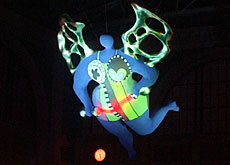
40 years of Niki’s nanas

Her gigantic, vividly painted, polyester female nana figures brought worldwide fame to avant-garde artist Niki de Saint Phalle.
First seen in 1965, her nanas can now be found in art collections in Paris, New York, Brussels, Tokyo, Amsterdam, Los Angeles, Geneva, and Lucerne.
Inspired by a pregnant friend, de Saint Phalle’s initial nana creations, made of papier-mache, yarn and cloth, had their first showing at a Paris exhibition.
The following year, she shot to fame with a collaborative large sculpture installation, hon-en-katedral, for the Moderna Museet in Stockholm, later a major collector of her work.
Over 100,000 people walked into the museum through an opening in the vagina of a six-ton, 27-metre-long (89 feet) polyester female figure, named hon. The most famous of her many nanas, it was a critical sensation.
De Saint Phalle affectionately referred to hon as “the biggest whore in the world” and suggested the inside be used as a bar, library, brothel, or chapel. More seriously, de Saint Phalle saw the nanas as a protest against women’s second-class status in society.
In Hanover, where de Saint Phalle bequeathed many works, three enormous nanas, named Sophie, Charlotte, and Caroline in honour of historically prominent locals, stand near the town hall.
Another famous nana, Traveller’s Angel, graces the main train station in Zurich, while inflatable versions were produced and distributed in the United States in the 1960s.
Eberhard Kornfeld, owner of the Kornfeld Gallery in Bern, puts part of the success of her nanas down to the fact that they are accessible to everyone, especially those with little knowledge of art.
“Classical art historians had difficulties with her,” acknowledged Kornfeld. “But this was another chapter in pop art.”
Cosmopolitan upbringing
Born in Neuilly-sur-Seine to a French banker and an American mother, de Saint Phalle attended exclusive private schools in New York City and spent summers in France.
She identified strongly with her French-American heritage, later becoming close to members of the avant-garde movement in both countries.
As a teenager, de Saint Phalle was drawn to literature, poetry and theatre. Married at 18, she began painting in a self-taught style.
She also had a career as a fashion model, working for French and American magazines, including Vogue, Elle, and Harper’s Bazaar.
At 22, de Saint Phalle moved to Paris with her husband, studying theatre, travelling through France, Italy, and Spain, and visiting museums and cathedrals.
Three years later she met renowned Swiss artist Jean Tinguely, leaving her husband and two children shortly thereafter to be with him.
Despite becoming a Swiss citizen and collaborating for years with Tinguely in a Fribourg studio, de Saint Phalle was overshadowed in Switzerland by her husband’s fame.
She was seen by some as Tinguely’s assistant or collaborator, rather than as an artist in her own right.
Tinguely’s shadow
But Kornfeld, who has exhibited de Saint Phalle’s work, believes this assessment is wrong, claiming she was more than her husband’s equal.
“Tinguely’s work had a certain importance – as did Niki de Saint Phalle’s. She was never in his shadow,” he said.
“During some periods of their life together, her work was even more important than his was.”
A multi-talented artist with diverse interests, de Saint Phalle worked variously designing theatre sets, costumes, architecture and jewellery.
She created one of the first celebrity perfumes, named after herself and marketed in blue and gold bottles with an entwined serpent logo.
A member of the avant-garde Nouveau Realistes, along with Christo, Tinguely and Yves Klein, de Saint Phalle was also friends with American artists in Paris, including Robert Rauschenberg and Jasper Johns.
She died on May 22, 2002, at the age of 71 in San Diego, California, from lung disease caused by the toxic fumes inhaled while working on her beloved polyester figures.
(Adapted from German by Kathleen Peters)
1930: Niki de Saint Phalle born just outside Paris.
1956: first solo exhibition of her paintings in St Gallen, Switzerland.
1959-60: separates from husband and moves in with Swiss kinetic sculptor Jean Tinguely.
1965: first exhibition in Paris of her nanas.
1978: construction of the Tarot Garden in Tuscany, Italy, begins.
2002: dies in California.

In compliance with the JTI standards
More: SWI swissinfo.ch certified by the Journalism Trust Initiative




























You can find an overview of ongoing debates with our journalists here . Please join us!
If you want to start a conversation about a topic raised in this article or want to report factual errors, email us at english@swissinfo.ch.